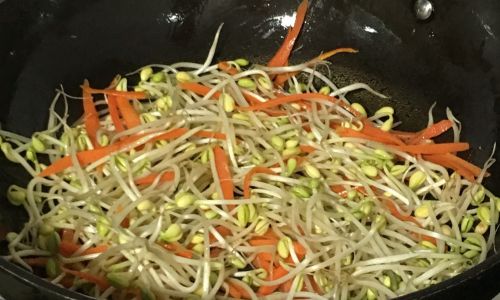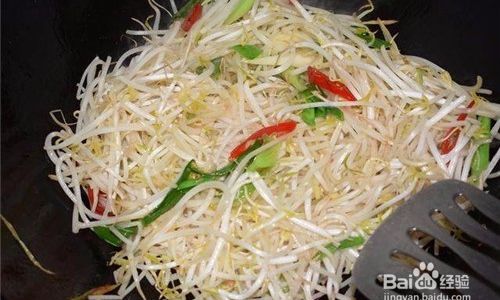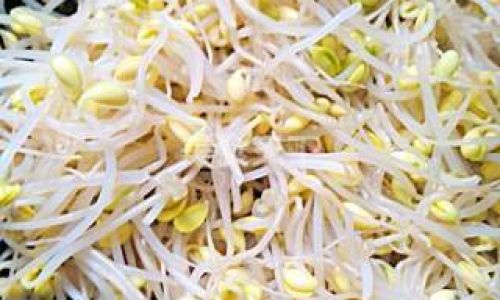Soybean sprouts, often overlooked in Western cuisine, are a staple in many Asian kitchens. Their crunchy texture, mild earthy flavor, and remarkable versatility make them a beloved ingredient in stir-fries, soups, salads, and more. Yet, achieving that ideal balance of tenderness and crispiness requires technique, attention to detail, and an understanding of how to elevate their natural taste. This article delves into the nuances of cooking soybean sprouts to perfection, exploring everything from selection and preparation to seasoning and creative variations. Whether you’re a novice cook or a seasoned home chef, this guide will equip you with the knowledge to transform this humble ingredient into a dish that steals the spotlight.
The Humble Soybean Sprout: A Nutritional Powerhouse
Before diving into cooking methods, it’s worth appreciating why soybean sprouts deserve a place on your plate. Rich in vitamins C and K, folate, and fiber, these sprouts offer a low-calorie, nutrient-dense addition to meals. They also provide a plant-based source of protein, making them an excellent choice for vegetarians and vegans. Beyond nutrition, their ability to absorb flavors while retaining their crunch makes them a canvas for culinary creativity.
Selecting the Best Soybean Sprouts
The journey to a great dish begins at the grocery store or market. Freshness is non-negotiable when it comes to soybean sprouts. Look for bundles with firm, white stems and small, yellow-tipped leaves. Avoid sprouts with brown spots, slimy textures, or a sour smell—these are signs of spoilage. If possible, opt for organic or locally sourced sprouts, as they tend to have a sweeter, less bitter taste compared to mass-produced varieties.
Preparation: Rinsing, Trimming, and Drying
Proper preparation is the foundation of a stellar stir-fry. Start by rinsing the sprouts under cold water to remove any dirt or debris. Gently agitate them with your hands to dislodge hidden grit. Next, trim the roots. While some recipes call for leaving the roots intact, removing the thin, stringy ends (about 1/4 inch) ensures a cleaner texture and prevents a fibrous mouthfeel. Use a sharp knife or kitchen shears for this task.
After trimming, pat the sprouts dry with a clean kitchen towel or paper towels. Excess moisture is the enemy of stir-frying, as it can lead to steaming instead of searing, resulting in a soggy, less flavorful dish. For larger batches, spread the sprouts on a baking sheet lined with paper towels and air-dry them for 10–15 minutes.

The Science of Stir-Frying: Heat, Oil, and Timing
Stir-frying is a high-heat cooking method that demands precision. To achieve the coveted crisp-tender texture, follow these principles:
-
Preheat Your Wok or Skillet: A well-seasoned carbon-steel wok is ideal, but a large stainless-steel or cast-iron skillet works too. Heat the pan over medium-high to high heat until a drop of water evaporates instantly. This ensures the sprouts sear rather than steam.
-
Choose the Right Oil: Use an oil with a high smoke point, such as peanut, vegetable, or avocado oil. Avoid olive oil, which can burn at high temperatures and impart a bitter taste.
-
Aromatics First: Start by sautéing aromatics like garlic, ginger, or shallots in hot oil. This infuses the oil with flavor, creating a base for the dish.
-
Add the Sprouts: Toss the sprouts into the pan and stir vigorously to coat them in oil. Avoid overcrowding the pan, as this lowers the temperature and leads to steaming. Cook in batches if necessary.

-
Season Wisely: Soy sauce, oyster sauce, or a splash of rice vinegar can enhance the sprouts’ natural flavor without overwhelming them. Add seasonings gradually, tasting as you go.
-
Master the Timing: Soybean sprouts cook quickly—usually 3–4 minutes. Overcooking results in mushiness, while undercooking leaves them raw and starchy. Look for a slight wilt and vibrant green hue.
Flavor Pairings: Beyond the Basics
While a simple stir-fry with garlic and soy sauce is delicious, soybean sprouts shine when paired with complementary flavors. Consider these combinations:
- Spicy Kick: Add fresh chili peppers, red pepper flakes, or a dollop of gochujang (Korean fermented chili paste) for heat.
- Umami Boost: Incorporate fermented ingredients like black bean sauce, miso, or dried shrimp for depth.
- Herbaceous Notes: Toss in fresh cilantro, basil, or mint just before serving for a refreshing finish.
- Nutty Crunch: Garnish with toasted sesame seeds, crushed peanuts, or fried shallots for texture.
- Citrus Zing: A squeeze of lime or lemon juice brightens the dish and balances richness.
Regional Variations: Exploring Global Cuisines
Soybean sprouts are a common ingredient in Korean, Chinese, and Southeast Asian cuisines, each with its own preparation style:
-
Korean-Style Soybean Sprout Salad (Kongnamul Muchim):

- Blanch the sprouts briefly, then toss with sesame oil, soy sauce, minced garlic, green onions, and sesame seeds.
- Serve chilled as a banchan (side dish) or with rice.
-
Chinese Stir-Fry with Fermented Black Beans:
- Stir-fry sprouts with garlic, ginger, and fermented black beans.
- Finish with a splash of Shaoxing wine and a drizzle of sesame oil.
-
Thai-Inspired Basil Stir-Fry:
- Sauté sprouts with Thai basil, chili, garlic, and fish sauce.
- Add diced tofu or shrimp for protein.
-
Vietnamese-Style Noodle Bowls:
- Use cooked soybean sprouts as a crunchy topping for bun bowls.
- Pair with fresh herbs, pickled vegetables, and a nuoc cham dressing.
Troubleshooting Common Pitfalls
Even experienced cooks encounter hiccups. Here’s how to fix them:
- Soggy Sprouts: Ensure the pan is hot enough, and avoid adding liquid (like soy sauce) too early. If using a non-stick pan, consider switching to a wok for better heat retention.
- Bland Flavor: Aromatics are key. Double the garlic or ginger, and don’t skimp on salt or umami-rich ingredients.
- Uneven Cooking: Stir constantly to prevent burning, and cook in batches if your pan is small.
Creative Serving Ideas
Soybean sprouts aren’t limited to stir-fries. Experiment with these ideas:

- Wraps and Lettuce Cups: Use them as a filling for rice paper rolls or bibimbap bowls.
- Salads: Combine raw or lightly blanched sprouts with shredded carrots, cucumbers, and a tangy vinaigrette.
- Soups: Add them to miso soup or hot pot for a crunchy contrast.
- Fritters: Mix chopped sprouts into pancake or fritter batter for a savory breakfast.
Vegetarian and Vegan Adaptations
Soybean sprouts are inherently plant-based, but certain seasonings (like oyster sauce) may not be. Substitute with vegan alternatives:
- Use mushroom-based stir-fry sauces instead of oyster sauce.
- Add nutritional yeast for a cheesy flavor without dairy.
- Incorporate smoked paprika or liquid smoke for a meat-like depth.
Preserving Leftovers: Storage and Reheating
Leftover stir-fried sprouts can be stored in an airtight container in the refrigerator for up to 3 days. To reheat, use a skillet over medium heat to maintain crispness. Avoid microwaving, as it can turn the sprouts mushy.
The Final Touch: Presentation and Garnishes
A visually appealing dish enhances the dining experience. Garnish your soybean sprouts with:
- A sprinkle of toasted sesame seeds.
- Thinly sliced green onions or chives.
- Fresh cilantro or basil leaves.
- A drizzle of chili oil or sesame oil.
- Microgreens or edible flowers for a modern twist.
Conclusion: Elevating the Everyday
Soybean sprouts may seem mundane, but with the right techniques and creativity, they can become the star of any meal. By focusing on freshness, mastering stir-fry basics, and exploring global flavors, you’ll unlock their full potential. Whether you’re craving a quick weekday side dish or a showstopping centerpiece, these crunchy sprouts deliver—nutritionally, texturally, and in flavor. So grab your wok, heat the pan, and let the humble soybean sprout surprise you.





0 comments